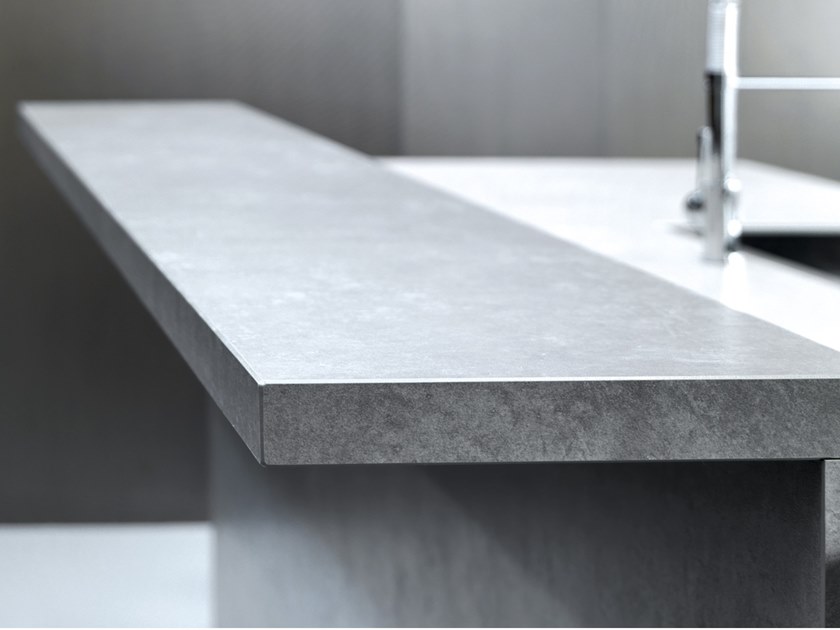
Sintered Materials: Practically perfect in every way!
Sintered materials are rising in popularity across the world, with a significant rise in worktops, bathrooms and flooring seen across the UK and beyond. But why? In our latest blog, we are going to look at what a sintered material actually is, why it is so popular and the tooling and advice you need to cut it.

What is Sintered Material?
The act of sintering is to process and form a solid mass by applying heat or pressure without melting it past the point of liquefaction. Sintered material is a hard, ultra-compact material made up of fine-grained materials such as clay, feldspar or flint and silica that has gone through this process. These fine grains are crushed, cleaned and mixed before being rolled into the mould to form the desired shape. This action helps to destress the slab. The composition is then fired to set. After this a sintered material such as porcelain can be classified into three different categories depending on the temperature reached during the firing process these are; hard-paste, soft-paste and bone china.
Why Sintered Material?
Sintered material has become so popular as like quartz it is durable with a low porosity, which means it can stand up to the test of a busy household. Let’s take a look at a few of the advantages of choosing porcelain.
1 - Low Porosity
This means surfaces need little or no sealing to protect it making it a low maintenance addition to any household or business. Its water resistance ability makes it a welcome addition to bathrooms, kitchens and outside patios.
2 – Stain, Scratch And Heat Resistant
Unlike popular worktop surfaces like granite and quartz, sintered material is naturally stained, scratch and heat resistant, with some varieties even boasting fireproof qualities. Its durability to scratches makes it an ideal choice for flooring.
3 – Cheaper
Despite having many superior qualities to granite, marble and quartz, sintered material is usually priced much cheaper than natural stone.
4 – Lots of Varieties
Because sintered materials are a man-made material, it can be very flexible with its design. It tends to be most popular when it is made to look like natural stone. Such as the popular veined marble look. However, it can be made to suit a variety of different styles and colour themes.
5 – Suitable for inside and outside
Due to its durability, low porosity and stain and heat resistance sintered materials are suitable to use insides, outside and anywhere in the home. This means if you have the type of customer who prefers their house layout to flow with the same stone and design then this is the obvious choice. The inside-out look is a popular modern look, where the stone from the kitchen floor flows out onto the patio. This look is more commonly achieved with sintered material floor tiles.
Working with Sintered materials
Cutting sintered materials requires similar tooling to that in which you would use for other UCS materials such as DEKTON. Sintered materials are harder and denser, which means there is an increased risk of chipping the material during the cutting process. Our technical experts at Stonegate advise to use additional water when cutting and to reduce the speed of the blade to 50 % as you enter and exit the stone to reduce the likelihood of ‘chipping out’.
Recommended basic tooling for cutting Sintered material is:
35mm Thin Wall Core Drill (All other sizes available too)
For further advice on tooling please contact our technical team who will be happy to help.
EXPLORE THE DIAMOND STONE CUTTING RANGE HERE
Further reading on the Stonegate Tooling Blog:
- REACH Regulations - What You Need To Know: Better understand the new REACH Regulations and what your responsibilities when it comes to compliance are!
- Safely Moving Stone In Your Workshop: Learn how to better lift and handle stone to avoid the risk of injury to your team.
- Understanding The Dangers Of Stone Dust: Silica dust is an everyday risk for stone fabricators but its dangers simply can't be underestimated, read more from Stonegate.
- Stonegate, The UK's Most Trusted Provider Of Specialist Tooling To Stone Fabricators: Discover how Stonegate supports your business with our commitment to being the very best.
- How Our Next-Day Stone Tools Stock Keeps You In Business: Read how our unbeatable supply is essential to keep your business running and what we do to constantly ensure you have the products you need.
- Stonegate, The Exclusive Worldwide Distributor For Status Diamond Tooling!: We're thrilled to provide the world's most innovative CNC tools from leading brand, Status Diamond Tooling.
- Stone Slab Protection Film: Exploring SlabWrap©: Explore more from our range of stone slab protection products to make your business more efficient and profitable.
- 10 quick tips for stone cutters: 10 quick tips for cutting stone, from the experts
- All you need to know about Textured Worktops: A lowdown on the different varieties of texture and how to achieve them
- Quartz vs Granite: A Countertop Derby: A unique look at these two kitchen surfaces







